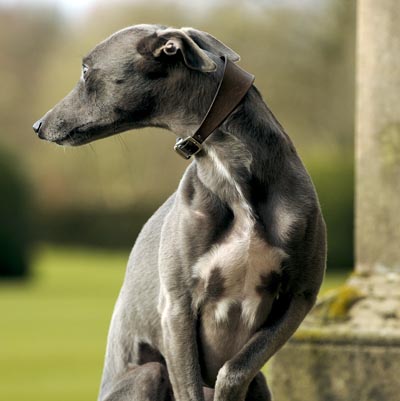The whippet: to the manor born
At home on the sofa or on the hunting field, whippets are the most elegant of sight hounds


The whippet has been both companion of kings and a peasants' hunting dog. It has sat sphinx-like by the firesides of great country houses (‘What an enchanting bit of beige,' remarked Ivor Novello on meeting Studley, who would go picking-up with his owner, the Duchess of Devonshire), and it has been the family's pride, far better fed than the children, among the grey, terraced houses of northern mining towns where, until the First World War, whippet racing was more popular than the greyhound version.
It's probably fair to say that the whippet has since shed that rather over-used flat-cap association. Catherine, Countess of St Germans, a fashion journalist, has a pair of blue whippets, Roo and Lark, who stalk the grounds of Port Eliot in Cornwall when they're not modelling for highend labels. ‘Whatever their pose, they somehow manage to look elegant, with their elongated limbs,' she explains. ‘Their looks were part of it, but their natures were the overwhelming thing that did it for me-mine are absolutely my shadows.'
Initially, Lady St Germans faced opposition from her husband, who saw whippets as ‘shivering, bug-eyed runts', but Roo, a sturdy animal from Lincolnshire coursing stock, won him over. Roo was followed by Lark, who came from Emma Hanbury, their neighbour in Devon, and now the Earl admits to an ‘obsession'. Roo hosts an annual Whippet Tea Party in aid of charity and has acquired a dedicated local following through ‘dictating' a regular column to his master for the Western Daily Press.
‘They tick all the boxes,' says Mrs Hanbury of her whippets, Lily and Violet. ‘They're incredibly affectionate, not too bouncy and annoying and they don't smell.' Another blue whippet bred by Mrs Hanbury holds court at Houghton Hall, the Palladian house in Norfolk that's home to her daughter Rose Cholmondeley. Lady Cholmondeley thinks her family's fixation with the breed began in her childhood, when they met Lucian Freud and his brindle whippet Pluto (the dog often appears as the logo on his daughter Bella Freud's fashion label). ‘They're gentle-natured and they love human company,' declares Lady Cholmondeley. ‘I trust Benjy completely with my twin boys; they are only three and quite boisterous, but he's incredibly long-suffering.'
If whippets seem to the manor born, there is a good reason. Mary Lowe, widely considered the grande dame of whippets in this country, believes their provenance is distinctly patrician. In the definitive work on the breed, The English Whippet (Boydell Press, 1984), Mrs Lowe shows that, rather than originating in the north of England in the 19th century, dogs of whippet type-until the breed was registered with the Kennel Club in 1891, any quick-moving small dog was known as a whippet-had long been popular with the nobility. She finds proof in paintings of the Grand Tour era, such as the portrait of the 7th Earl of Northampton (1758), by Pompeo Batoni, now in the Fitz-william Museum, with the Earl's dog in a ‘thoroughly whippety position'.
Mrs Lowe, who bred under the Nimrodel prefix, isn't surprised that whippets are enjoying a resurgence they're the most popular of the Kennel Club's hound group, with 3,084 registrations in 2012. ‘They have an air of aristocracy; they appeal to people with an eye for beauty and they go well with horses. I was brought up with horses and my eye translated quite easily. I do think that, when you're looking at a really beautiful whippet, you're looking at a Derby winner.'
Victoria Stapleton, founder of Brora, agrees there is no finer sight than a whippet in full flight. She was introduced to the breed by her friend Emma Bridgewater, who had one called Beetle. Miss Stapleton's pair, Honey Bee and Flee Fly, are Beetle's granddaughter and great-granddaughter. They've been appearing in shoots for Brora cashmere since they were puppies. ‘They're queens of the sofa and they don't like being rele-gated,' comments Miss Stapleton. But although whippets are most content by the fireside, you can click your fingers and they'll be ready to go, noses quivering at the door. ‘They're very much sight hounds and there's nothing more exciting than seeing a whippet give chase.'
Sign up for the Country Life Newsletter
Exquisite houses, the beauty of Nature, and how to get the most from your life, straight to your inbox.
Whippets are an explosive breed and will go from 0 to 35mph in seconds. Mary Lowe advises that it's possible to give them quite a lot of exercise without doing much yourself-stand still and they'll run round you. ‘As long as you give them one really good blast a day, they'll settle quite happily,' agrees another cashmere designer, Claire Morgan. Mrs Morgan's whippet, Linnet, gets to curl up in one of her company Plum Trading's super-fine, extremely expensive Henley jumpers, which was returned by a customer who had shrunk it.

But they're a dog that's equally at home in town. The Holland Park-based novelist Sebastian Faulks has Hector and Robin Birley's Chester and Arnie love an early-morning romp in Green Park before returning to his Mayfair club, 5, Hertford Street, where breakfast is cooked for them. Members might find Chester or Arnie enjoying a snooze on one of the club's sumptuous sofas and woe betide anyone who turfs them off. ‘I don't believe in that,' says Mr Birley. ‘They're very sensitive creatures; you can't shout at them as you might a gundog.' He even admits that he's ‘slept on the sofa a few times so as not to disturb them on the bed'.
One former coursing champion was trained on the squirrels of Battersea Park and Mr Birley's Arnie was also a ‘huge squirrel catcher' in his youth, grabbing up to five an hour: ‘He'd eat the whole thing, except for the intestines and the tail.' Mrs Lowe believes that the outlawing of hare coursing (in the 2005 Hunting Act) has resulted in a ‘spindlier specimen'. Breeders, she feels, no longer need to produce the good conformation of a coursing dog that can twist and turn with the hare. Good coursing lines still exist, however, and the breed is remarkably free from hereditary problems.
The main downside is that the instinct to chase is greater than that to obey. ‘They are a sight hound,' explains Mrs Lowe, ‘and when they see something in the distance, you do hope that it's a rabbit and not someone's Yorkshire terrier! But you can train them; you should discipline them and be responsible.' For Miss Stapleton, this has meant installing an electric fence around her 15-acre property in Hertfordshire to curb Honey Bee and Flee Fly's propensity for chasing muntjac. ‘You hear all these squeals and excitement and it's quite nerve-wracking because the whippet's skin is terribly thin. They have a lot of war wounds.'
Despite the whippet's slender figure, thieving is another characteristic. ‘There's a reason why they're called "whippets",' exclaims Claire Morgan, who has found hers ‘cruising around the kitchen table on her hind legs'. Other owners report finding theirs actually on the table and Lady St Germans remembers a ‘fabulous Victoria sponge that just disappeared'. Whippets attending her annual tea party ‘can't believe their luck'-they're even allowed to stand on the table and wolf the food. However, cream cakes, leftovers and squirrels all melt away in the whippet's svelte figure, for it is the supermodel of the dog world.
Country Life is unlike any other magazine: the only glossy weekly on the newsstand and the only magazine that has been guest-edited by HRH The King not once, but twice. It is a celebration of modern rural life and all its diverse joys and pleasures — that was first published in Queen Victoria's Diamond Jubilee year. Our eclectic mixture of witty and informative content — from the most up-to-date property news and commentary and a coveted glimpse inside some of the UK's best houses and gardens, to gardening, the arts and interior design, written by experts in their field — still cannot be found in print or online, anywhere else.
-
 Six rural properties with space, charm and endless views, as seen in Country Life
Six rural properties with space, charm and endless views, as seen in Country LifeWe take a look at some of the best houses to come to the market via Country Life in the past week.
By Toby Keel
-
 Exploring the countryside is essential for our wellbeing, but Right to Roam is going backwards
Exploring the countryside is essential for our wellbeing, but Right to Roam is going backwardsCampaigners in England often point to Scotland as an example of how brilliantly Right to Roam works, but it's not all it's cracked up to be, says Patrick Galbraith.
By Patrick Galbraith